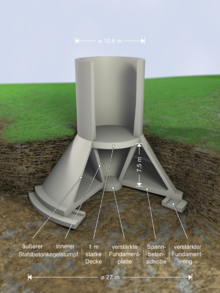Ring foundation

A ring- shaped foundation of a building is called a ring foundation . This type of foundation is used in particular for tower structures over 100 meters high.
The loads of very high tower structures with a cylindrical tower shaft can be transferred to the building ground either via circular foundation plates or a circular ring. Because of the large core width , i.e. the distance of the resultant from the center of gravity of the base area, at which the limit of the pressed base area area reaches the center of gravity, the ratio between uneven ground pressures due to wind loads and constant even soil pressures due to its own weight is significantly lower in the case of the circular ring than with corresponding ones Circular plates. In addition to soil characteristics and groundwater conditions, functional framework conditions can also require a ring foundation. In the case of television or telecommunications towers, in particular , more stringent criteria apply to the uneven settlement and rigidity of the structure in storms than in the case of pure observation towers .
As a rule, the shaft diameter at the foot of the structure is significantly smaller than that of the ring foundation, so that a corresponding transmission system is necessary between the two. Either a continuously expanding shaft construction is used (for example at the Donnersberg transmitter or the Ostankino television tower ) or various steep truncated cone constructions . If the subsoil is poor, the ring foundation is placed on foundation piles.
literature
- Jörg Schlaich , Ulrich Otto: On the foundation of high reinforced concrete towers , IABSE Congress Report , Volume 10, 1976, pp. 349–354. ( here online )
- Fritz Leonhardt : Tall, slim buildings , IABSE Congress Report, Volume 9, 1972, pp. 213–242. ( here online )